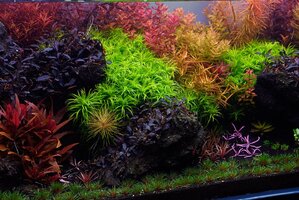This threads intense. These experiments are pet projects on our end. It’s too hard to control and perform excellent empiricism.
As hobbyists, I think it’s the wrong track to be honest.
I think we need to define our goals - which are dynamic and changing … like our tanks.
We get consumed by this glass box. It drives us mad. It’s chaos. But it is chaos, a dynamic equilibrium of interconnected variables, a spiders web intricately woven - a snowflake. Sorry feeling poetic with an early morning coffee.
i don’t want to create a newbie guide/progression guide for a nice path to take - but ultimately what the hobbyists needs is a set of tools/know how to maneuver the situations that arise. How to recorrect a tank after coming back from vacation. The way you do that is not the same as how to re correct a tank after dropping in biscuits and/or loads of fish food.
How to recorrect after you run out of co2.
Most people struggle to get it to the point where you are doing re correction.
It’s ironic - when you see the recorrections and see all the ways you could approach a situation , you can see why all the methods work.
This threads crazy long now … and I haven’t read it all … but everyone is right whether we like it or not. For each argument, we need to trace back why the observation could have happened from first principles.
Plant need food, plant get food.
The leaf is more sensitive to changing parameters since it doesn’t have the same environment and structure as a root.
So use highest probability agreed upon targets based on the shoulders of giants from the past 100 years.
They made a mistake about ferts and algae because their co2 sucked. And we’re now making a mistake about light. Turning down your light simply makes the inefficiencies of your system unseen - the algae dont get to exploit the system because you maintenance before it gets the chance since you’ve choked the energy in the system. And plants are ugly relative to high light.
Tom Barr made EI for fun. He was curious. He wanted to test boundaries. To achieve plant forms we all love, it’s hard mode - plain and simple. And as
@Simon Cole has stated - an anecdote on water changes. Increasing water change frequency increasing control - plain and simple. The more times you reset to control, the less change - the leaf sensitivity can adapt via genetics etc … to an extent because of N/P pathways under rich conditions … and I don’t want to bang on about this I already did 50 pages ago.
Terrestrial plants literature use soil ratios.
Do you see something? Aquarium hobbyist talk about water column dosing. Terrestrialist talk about root dosing. They both are facilitated with water but have a different interface: a root and a leaf.
And they are physiologically different.
We need to harness the learning of the past - and guess who beat us to the chase our friend Dennis Wong.
He toned down EI, kept the potassium from ADA, and uses osmocote while at the same time advocating for low KH and moderate GH? Basically he favours leaf sensitivity - picks the middle road - give K for root nutrition mobility … then blasts the root with super cheap soil doped with osmocote (terrestrial research shoulder) … no wonders half the world literally uses his line.
The die hard ADA are old - they’ve been using it since before Wong came into the picture. And they are sponsored or they have money and are pleased with the results so don’t care to change.
Now I’m rambling … oh ya … everyone is right … and I love UKAPS. ❤️
Josh



